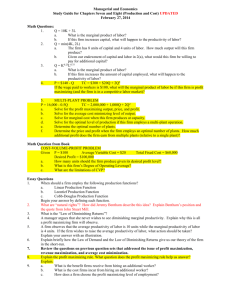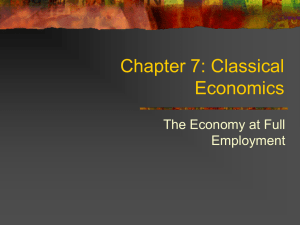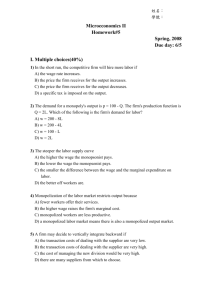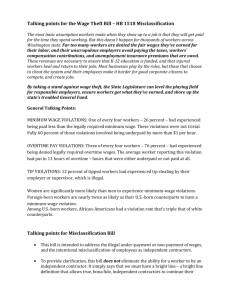Chapter 5
advertisement
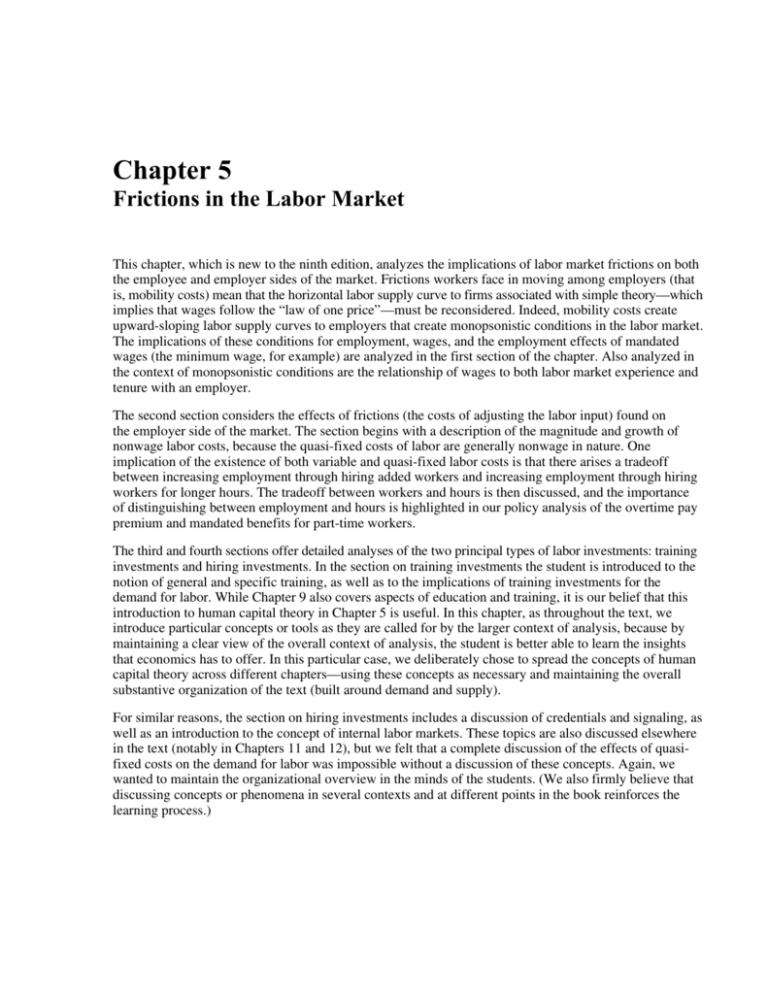
Chapter 5 Frictions in the Labor Market This chapter, which is new to the ninth edition, analyzes the implications of labor market frictions on both the employee and employer sides of the market. Frictions workers face in moving among employers (that is, mobility costs) mean that the horizontal labor supply curve to firms associated with simple theory—which implies that wages follow the “law of one price”—must be reconsidered. Indeed, mobility costs create upward-sloping labor supply curves to employers that create monopsonistic conditions in the labor market. The implications of these conditions for employment, wages, and the employment effects of mandated wages (the minimum wage, for example) are analyzed in the first section of the chapter. Also analyzed in the context of monopsonistic conditions are the relationship of wages to both labor market experience and tenure with an employer. The second section considers the effects of frictions (the costs of adjusting the labor input) found on the employer side of the market. The section begins with a description of the magnitude and growth of nonwage labor costs, because the quasi-fixed costs of labor are generally nonwage in nature. One implication of the existence of both variable and quasi-fixed labor costs is that there arises a tradeoff between increasing employment through hiring added workers and increasing employment through hiring workers for longer hours. The tradeoff between workers and hours is then discussed, and the importance of distinguishing between employment and hours is highlighted in our policy analysis of the overtime pay premium and mandated benefits for part-time workers. The third and fourth sections offer detailed analyses of the two principal types of labor investments: training investments and hiring investments. In the section on training investments the student is introduced to the notion of general and specific training, as well as to the implications of training investments for the demand for labor. While Chapter 9 also covers aspects of education and training, it is our belief that this introduction to human capital theory in Chapter 5 is useful. In this chapter, as throughout the text, we introduce particular concepts or tools as they are called for by the larger context of analysis, because by maintaining a clear view of the overall context of analysis, the student is better able to learn the insights that economics has to offer. In this particular case, we deliberately chose to spread the concepts of human capital theory across different chapters—using these concepts as necessary and maintaining the overall substantive organization of the text (built around demand and supply). For similar reasons, the section on hiring investments includes a discussion of credentials and signaling, as well as an introduction to the concept of internal labor markets. These topics are also discussed elsewhere in the text (notably in Chapters 11 and 12), but we felt that a complete discussion of the effects of quasifixed costs on the demand for labor was impossible without a discussion of these concepts. Again, we wanted to maintain the organizational overview in the minds of the students. (We also firmly believe that discussing concepts or phenomena in several contexts and at different points in the book reinforces the learning process.) 26 Ehrenberg/Smith • Modern Labor Economics: Theory and Public Policy, Tenth Edition ! List of Major Concepts 1. Simple theory assumes the labor supply curve to individual employers is horizontal and that firms can increase or decrease labor without cost. 2. Horizontal labor supply curves to employers imply that workers are so sensitive to small wage differences across employers that the “law of one price” holds (workers of equal skill are paid the same wage). 3. Wage differences within skill groups across firms and regions suggest that mobility costs for workers across employers are nonzero. 4. Higher mobility costs for employees result in more steeply-sloped (less elastic) labor supply curves to firms. 5. An upward-sloping labor supply curve to a firm creates a marginal labor expense curve that lies above, and rises more steeply than, the labor supply curve. For this reason, we can say that employee mobility costs create “monopsonistic” conditions in the labor market. 6. With monopsonistic conditions, firms must decide on both employment levels (found where marginal revenue product equals marginal expense of labor) and wages (finding the wage required to yield the profit-maximizing employment level). 7. Under monopsonistic conditions, leftward shifts in the labor supply curve that maintain the supply curve’s upward slope will have the conventional effect of raising wages and reducing employment. 8. Under monopsonistic conditions, mandated wage increases cause the labor supply curve to be horizontal at the mandated wage level. This can lower the marginal expense of labor even if wages are increased, potentially leading to nonnegative employment changes in the short run. 9. In the long run, mandated wage increases that are accompanied by increases in employment will increase firms’ labor costs and cause some firms to cease production (which of course reduces employment). 10. The presence of monopsonistic conditions in the labor market offers an explanation for why estimated employment losses associated with minimum-wage increases have been smaller than expected, given the elasticity of labor demand curves estimated from wage changes arising from market forces. 11. Monopsonistic conditions imply that to some extent a worker’s wage rate depends on luck. 12. With employee mobility costs, wages received by an individual will tend to improve with labor market experience, as the individual accumulates opportunities to search for improved employment offers. 13. Workers fortunate to find high-wage jobs will tend to stick with their employers, which helps explain why higher wages are associated with longer job tenures. 14. The relative growth of wage and non-wage costs is presented. Chapter 5 Frictions in the Labor Market 27 15. Frictions on the employer side of the market arise from the costs of adjusting the labor input. These costs have been called “quasi-fixed” costs of employment, and they take the form of employee benefits that are associated with the number of workers rather than the hours of work, and with labor investments made by employers. 16. The essential characteristic of an investment is that resources are expended in the current period and returns are received later; the principal types of labor investments that firms undertake relate to training and hiring. 17. There are both explicit and implicit costs of job training. 18. Employee benefits are categorized and the types typically received are listed. 19. The presence of quasi-fixed costs causes an employment/hours tradeoff, and the firm must determine its optimum mix of employment and hours per worker. 20. Increased overtime pay premiums that might be required under the Fair Labor Standards Act would tend to reduce the use of overtime, but whether they increase the number of workers employed depends on the size of the reduction in total labor hours demanded. 21. The distinction between general and specific training is defined, and the effects of specific training on the relationship between wages and marginal productivity is analyzed. 22. Training investments are recouped through the creation of a “surplus” (a gap between marginal product and wage) that also cushions the worker from layoffs over the business cycle. 23. The presence of hiring costs induces firms to use credentials and internal labor markets in the recruiting, selection, and promotion processes. 24. Like training costs, hiring investments increase the productivity of selected job applicants (by distinguishing among them on the basis of productivity), and they are recouped by paying wages less than productivity. ! Answers to Even-Numbered Review Questions 2. Why do upward-sloping labor supply curves to firms cause the marginal expense of labor to exceed the wage rate? Answer: With upward-sloping labor supply curves, firms wanting to increase their number of employees must increase the wage offers for both their added workers and their existing workers. Thus, the marginal expense of labor exceeds wages paid to the added workers. 4. “Minimum wage laws help low-wage workers because they simultaneously increase wages and reduce the marginal expense of labor.” Analyze this statement. Answer: This statement has two aspects. First, minimum wage laws can increase wages and reduce the marginal expense of labor if the labor market is characterized by monopsonistic conditions and the minimum wage increases are not “too large” (that is, they do not impose a wage higher than the pre-existing marginal expense of labor). Second, however, these changes can only help workers if the higher wage bills faced by employers do not drive their employers out of business. 28 Ehrenberg/Smith • Modern Labor Economics: Theory and Public Policy, Tenth Edition 6. Workers in a certain job are trained by the company, and the company calculates that to recoup its investment costs the workers’ wages must be $5 per hour below their marginal productivity. Suppose that after training, wages are set at $5 below marginal productivity, but that developments in the product market quickly (and permanently) reduce marginal productivity by $2 per hour. If the company does not feel it can lower wages or employee benefits, how will its employment level be affected in the short run? How will its employment level be affected in the long run? Explain, being sure to define what you mean by short run and long run! Answer: In the short run (that is, when training investments have already been concluded, so all that is variable is the employment levels of trained workers), marginal revenue product still exceeds wages by $3 per hour, so it is advantageous for the company to continue employing workers it has already trained. The company is not making back enough to make the training a good investment, but making back $3 per hour is better than laying off the workers and making back nothing! Thus, workers will not be laid off. In the long run (that is, when the company is deciding about investing in new workers), the $3 payback per hour is not sufficient to justify the training investment if wages remain as they are. Thus, the firm will not hire and train new workers under the current circumstances. Employment will fall as the firm fails to replace those who leave, and the decline in employment will eventually serve to raise the marginal productivity of labor. The decline in employment will stop when the marginal revenue product of labor is once again $5 greater than the wage rate. 8. The manager of a major league baseball team argues: “Even if I thought Player X was washed up, I couldn’t get rid of him. He’s in the third year of a four-year, $24 million deal. Our team is in no position to eat the rest of his contract.” Analyze the manager’s reasoning using economic theory. Answer: The manager is ignoring the fact that the cost of the player will be $24 million over the period whether the player is on the team or not. Teams are always better off maximizing profits, even if they are losing money under their current conditions, and the team may be able to generate more profits if it replaces Player X. The condition for replacement is that the difference between the marginal revenue product of the new player and that of Player X exceeds the salary of the new player (the marginal expense of continuing Player X is zero). 10. The state of North Carolina has a program for state-subsidized training of disadvantaged workers at its community colleges. Employers adding at least 12 jobs can arrange for a community college to provide a program tailored to the individual firm. The college places ads for new hires and screens the applicants, the firms choose whom they want trained from the list supplied by the college, and the college provides the training (using equipment supplied by the firm). Finally, the firm selects employees from among those who successfully complete the training. Trainees are not paid during the training period. Analyze the likely effects on wages, employment, and hours of work associated with adopting this program. Answer: This program reduces the hiring and training investments required by firms, thus increasing both employment and wages (firms have fewer investment costs to recoup). The program could reduce the hours each employee works per week, however, because the reduction in training costs creates incentives to substitute workers for hours per worker. Chapter 5 Frictions in the Labor Market ! Answers to Even-Numbered Problems 2. Assume that the labor supply curve to a firm is the one given in Problem 1 above. If the firm’s marginal revenue product of labor (MRPL) = 240 – 2E, what is the profit-maximizing level of employment (E * ) and what is the wage level (W * ) the firm would have to pay to obtain E * workers? 29 Answer: Total labor costs to the firm (C) equal WE, which, expressed in terms of E, are as follows: C = E × E /5 = 0.2 E 2 To maximize profit, the firm’s marginal revenue product of labor, 240 – 2E, must equal the marginal expense of labor: dC/dE = 0.4E Thus, for profit-maximization the following must hold: 240 – 2E = 0.4E Solving the above equation for E yields E * = 100. Plugging E = 100 into the labor supply equation (E = 5W) and solving for W yields W * = $20. 4. As with the own-wage elasticity of demand for labor, the elasticity of supply of labor can be similarly classified. The elasticity of supply of labor is elastic if elasticity is greater than 1. It is inelastic if the elasticity is less than 1, and it is unitary elastic if the elasticity of supply equals 1. For each of the following occupations, calculate the elasticity of supply and state whether the supply of labor is elastic, inelastic, or unitary elastic. ES and W are the original supply of workers and wage. E ′S and W ′ are the new supply of workers and wage. a. %∆ES = 7, %∆W = 3 b. ES = 120, W = $8 E ′S = 90, W ′ = $6 c. ES = 100, W = $5 E ′S = 120, W ′ = $7 Answer: a. ηii = %∆ES /%∆W = 7/3 = 2.33 [elastic] b. [(90 − 120)/120]/[(6 − 8)/8] = (−30/120)/(−2/8) = 1 [unitary elastic] c. [(120 − 100)/100]/[(7 − 5)/5] = (20/100)/(2/5) = 0.5 [inelastic] 6. Teddy’s Treats, the dog biscuit company in Problem 5, has the following marginal revenue product of labor (MRPL): Number of Hours MRPL 18 19 20 21 22 29 27 25 23 21 30 Ehrenberg/Smith • Modern Labor Economics: Theory and Public Policy, Tenth Edition a. Add the marginal revenue product curve to the drawing in Problem 5. b. If Teddy’s Treats is maximizing profits, how many hours of labor will be hired? What wage will be offered? Answer: a. b. The profit-maximizing number of hours is 20 and Teddy’s Treats will offer a wage of $6 per hour. 8. Suppose the marginal expense of hiring another worker is $150 and the marginal expense of hiring current workers for an extra hour is $10. The added output associated with an added worker, holding both capital and average hours per worker constant, is 120. The added output generated by increasing average hours per worker, holding capital and the number of employees constant, is 7. If the firm is interested in maximizing profits, what should it do? Answer: For profits to be maximized, the following condition must hold: MEM /MPM = MEH /MPH With this firm, MEM /MPM = 150/120 = 1.25 and MEH /MPH = 10/7 = 1.43. Since the cost of an added unit of output produced by hiring more workers is less than the cost of an added unit of output produced by hiring workers for more hours, the firm should hire more workers and have each worker work fewer hours. Chapter 5 Frictions in the Labor Market 31 ! Suggested Essay Questions 1. Courts in Japan have recently begun to make awards to the families of workers who have been judged to have been “worked to death.” That is, employers have been increasingly required by courts to make large financial payments to the heirs of workers whose hours of work have been so long that they are judged to have played a role in causing their death. Use economic theory to analyze the likely labor-market effects of the growth in these awards, assuming that the wages in these jobs stay constant. Answer: These awards clearly increase the cost (wages held constant) of working employees overtime. Thus, we should observe a reduction in the required hours of work. Will these reduced hours be compensated by increased hiring of workers? Perhaps, but the overall costs of production in firms requiring long hours will rise, as will the cost of labor in these industries; thus, both the scale and substitution effects suggest that fewer total labor-hours will be worked than before the awards became more prevalent. 2. Currently, the U.S. Department of Transportation has a rule that limits commercial truck drivers to 90 hours of driving per week; after 40 hours per week, drivers’ hourly pay goes up by 50%. A proposed rule would reduce this limit to 60 hours of driving per week. Analyze the effects of this new limit on the total (for all drivers combined) labor-hours demanded by employers. Answer: Limiting hours to 60 means that to replace the lost hours firms would have to hire more workers. Because they had preferred paying overtime to drivers working 90 hours per week, we can infer that they saw this as less costly than hiring more drivers; thus, the new regulation will increase their costs. It is thus unlikely that all the lost hours of overtime will be replaced by the hours put in by new drivers.
